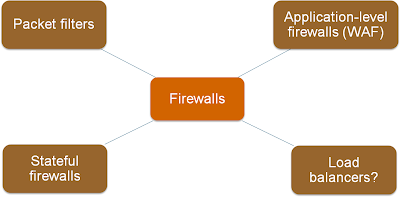Category: security
The Spectrum of Firewall Statefulness
One of the first slides I created for the Virtual Firewalls webinar explained various categories of traffic filters, from stateless (and fast) packet filters to application-level firewalls.
As always, the real life is not black-and-white; I found a whole spectrum of products in the wild.
IPv6 Secure Neighbor Discovery (SEND)
During the IPv6 Security webinar, Eric Vyncke explained the intricate details of IPv6 Security Neighbor Discovery (SEND) and the reasons it will probably never take off.
BGP Security draft adopted as IETF workgroup document
We published the first draft of the BGP Operations and Security document almost a year ago. In the meantime, the authors and Merike Kaeo presented the draft at RIPE and IETF meetings and collected literally tons of feedback (well documented in change logs) ... and finally the draft was adopted as IETF opsec workgroup document and republished under a new name.
We would never get this far without relentless Jerome Durand who did most of the editing heavy lifting, persistent nudging from Gunter Van de Velde and gracious help of Merike Kaeo. Thank you all!
Extending MPLS/VPN to Customer Sites
Erich has encountered a familiar MPLS/VPN design challenge:
We have Cisco's 2901s with the data license running MPLS/VPN on customer site (the classical PE is at the customer site). Should we use eBGP between CPE router and network edge router, some sort of iBGP route reflector design, or something completely different?
The “it depends” answer depends primarily on how much you can trust the routers installed at the customer site (CPE routers).
Reconnaissance in IPv6
In the introductory part of the IPv6 security webinar, Eric Vyncke explained how the huge IPv6 subnet sizes won’t stop a determined attacker, but will make the task of network or security engineers trying to take host inventory much harder.
IPv6 Router Advertisements Deep Dive
I’m constantly getting questions about the intricate interworking of various flags present in IPv6 Router Advertisement messages. Here’s a (hopefully comprehensive) summary taken primarily from RFC 4861.
IPv6 deployment IETF drafts
An incredible amount of IPv6 deployment documents has been published as IETF drafts recently, amongst them:
- Operational security considerations for IPv6 networks
- Design guidelines for IPv6 networks
- Stateless IP/ICMP Translation in IPv6 Data Centre Environments (aka IPv6-only data centers)
- Enterprise IPv6 Deployment Guidelines
Enjoy ... and don’t forget to join the v6ops mailing list ;)
What Exactly Are Virtual Firewalls?
Kaage added a great comment to my Virtual Firewall Taxonomy post:
And many of physical firewalls can be virtualized. One physical firewall can have multiple virtual firewalls inside. They all have their own routing table, rule base and management interface.
He’s absolutely right, but there’s a huge difference between security contexts (to use the ASA terminology) and firewalls running in VMs.
Virtual Firewall Taxonomy
Based on readers’ comments and recent discussions with fellow packet pushers, it seems the marketing departments and industry press managed to thoroughly muddy the virtualized security waters. Trying to fix that, here’s my attempt at virtual firewall taxonomy.
Firewalls in a Small Private Cloud
Mrs. Y, the network security princess, sent me an interesting design challenge:
We’re building a private cloud and I'm pushing for keeping east/west traffic inside the cloud. What are your opinions on the pros/cons of keeping east/west traffic in the cloud vs. letting it exit for security/routing?
Short answer: it depends.
IPv6 First-Hop Security: Ideal OpenFlow Use Case
Supposedly it’s a good idea to be able to identify which one of your users had a particular IP address at the time when that source IP address created significant havoc. We have a definitive solution for the IPv4 world: DHCP server logs combined with DHCP snooping, IP source guard and dynamic ARP inspection. IPv6 world is a mess: read this e-mail message from v6ops mailing list and watch Eric Vyncke’s RIPE65 presentation for excruciating details.
Don’t use IPv6 RA on server LANs
Enabling IPv6 on a server LAN with the ipv6 address interface configuration without taking additional precautions might be a bad idea. All modern operating systems have IPv6 enabled by default, and the moment someone starts sending Router Advertisement (RA) messages, they’ll auto-configure their LAN interfaces.
You MUST Take Control of IPv6 in Your Network
I’m positive most of you are way too busy dealing with operational issues to start thinking about IPv6 deployment (particularly if you’re working in the enterprise world; European service providers using the same “strategy” just got a rude wake-up call). Bad idea – if you ignore IPv6, it will eventually blow up in your face. Here’s how:
The best of RIPE65
Last week I had the privilege of attending RIPE65, meeting a bunch of extremely bright SP engineers, and listening to a few fantastic presentations (full meeting report @ RIPE65 web site).
I knew Geoff Huston would have a great presentation, but his QoS presentation was even better than I expected. I don’t necessarily agree with everything he said, but every vendor peddling QoS should be forced to listen to his explanation of the underlying problems and kludgy solutions first.
Dear VMware, BPDU Filter != BPDU Guard
A while ago I described the need for BPDU guard in hypervisor switches, and not surprisingly got a number of “it’s there” tweets seconds after vSphere 5.1 (which includes BPDU filter) was launched. Rickard Nobel also did a magnificent job of replicating the problem my blog post is describing and verifying vSphere 5.1 stops a BPDU denial-of-service attack.
Unfortunately, BPDU filter is not the same feature as BPDU guard. Here’s why.

